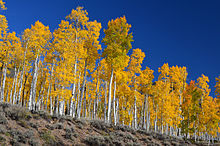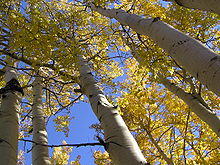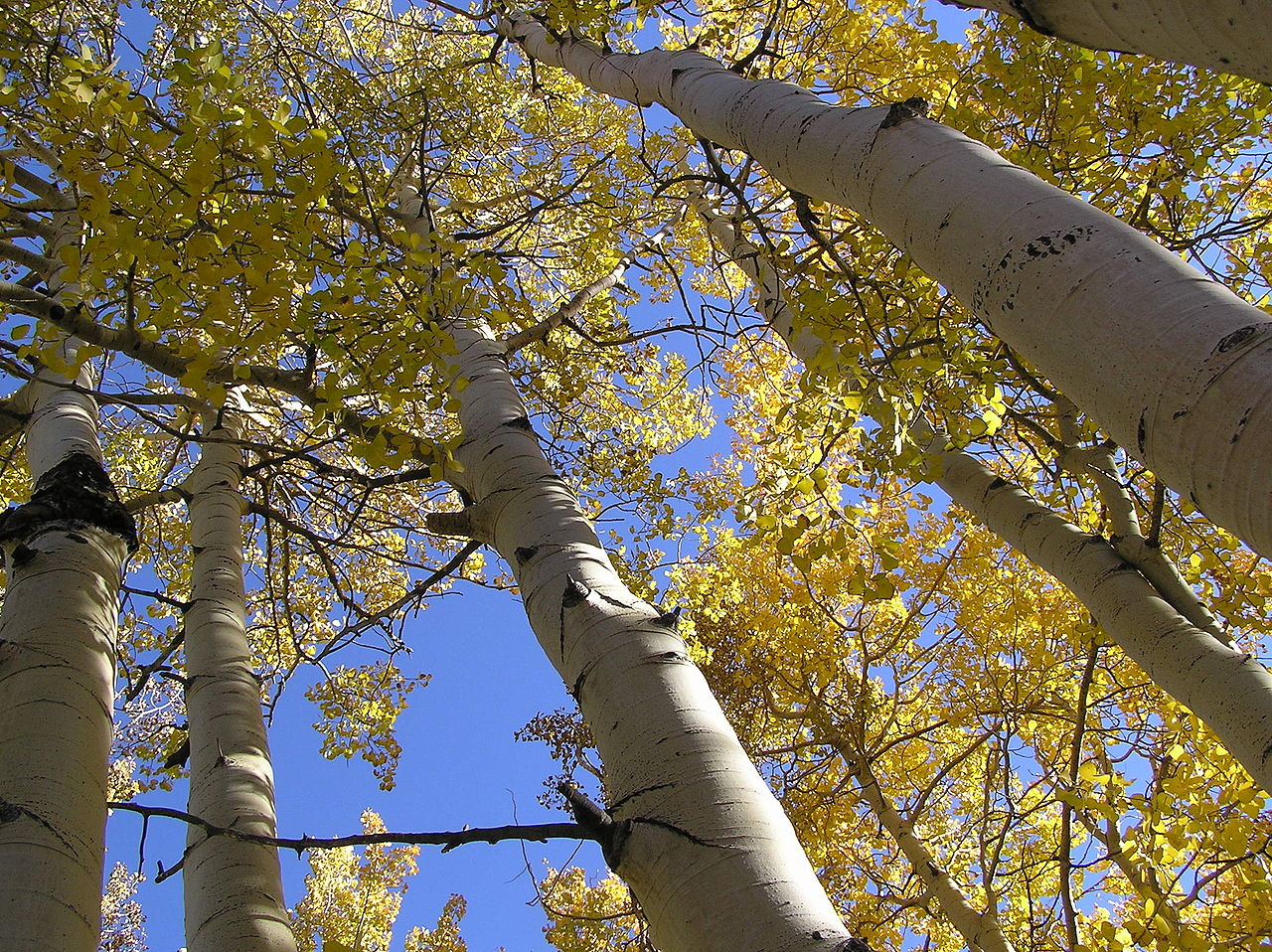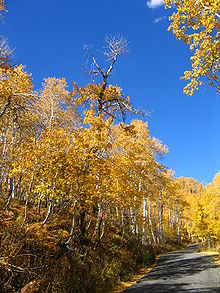 Pando aspen grove at Fishlake National Forest
Pando aspen grove at Fishlake National Forest
Pando (Latin for „I spread out“), also known as the Trembling Giant, is a clonal colony of an individual male quaking aspen (Populus tremuloides) determined to be a single living organism by identical genetic markers and assumed to have one massive underground root system. The plant occupies 43 hectares (106 acres) and is estimated to weigh collectively 6,000,000 kilograms (6,600 short tons), making it the heaviest known organism. The root system of Pando, at an estimated 80,000 years old, is among the oldest known living organisms.
Pando is located 1 mile (1.6 km) southwest of Fish Lake on Utah State Route 25, in the Fremont River Ranger District of the Fishlake National Forest, at the western edge of the Colorado Plateau in south-central Utah, United States.
Pando is currently thought to be dying. Though the exact reasons are not known, it is thought to be a combination of factors including drought, grazing, and fire suppression. The Western Aspen Alliance, a research group at Utah State University’s „S.J. & Jessie E. Quinney College of Natural Resources“, has been studying the tree in an effort to save it, and the United States Forest Service is currently experimenting with several 5-acre (2 ha) sections of it in an effort to find a means to save it.
A new study published in October 2018 concludes that Pando has not been growing for the past 30–40 years. Human interference was named as the primary cause, with the study specifically citing people allowing cattle and deer populations to thrive, their grazing resulting in fewer saplings and dying trees.
History
Pando is thought to have grown for much of its lifetime under ideal circumstances: frequent forest fires have prevented its main competitor, conifers, from colonizing the area, and a climate shift from wet and humid to semi-arid has obstructed seedling establishment and the accompanying rivalry from younger aspens.
During intense fires, the organism survived underground, with its root system sending up new stems in the aftermath of each wildfire. If its postulated age is correct, the climate into which Pando was born was markedly different from that of today, and it may have been as many as 10,000 years since Pando’s last successful flowering. Additionally, the post glacial climatic conditions have made it very problematic for new seeds to sprout. According to an Organization for Economic Co-operation and Development (OECD) report:
Clonal groups of P. tremuloides in eastern North America are very common, but generally less than 0.1 ha in size, while in areas of Utah, groups as large as 80 ha have been observed (Kemperman and Barnes 1976). In the semi-arid western United States, some argue that widespread seedling establishment has not occurred since the last glaciation, some 10,000 years ago (Einspahr and Winton 1976, McDonough 1985). Indeed, some biologists feel that western clones could be as old as 1 million years (Barnes 1966, 1975).
The clone now known as Pando was discovered in 1968 by researcher Burton V. Barnes, who continued to study it through the 1970s. Barnes had described Pando as a single organism based on its morphological characteristics alone; molecular techniques and methods developed since that time have largely substantiated those conclusions.
Building on Barnes’s earlier work, Michael Grant of the University of Colorado at Boulder re-examined the clone, named it „Pando“, and claimed it to be the world’s most massive organism in 1992.
In 2006 the United States Postal Service published a stamp in commemoration of the aspen, calling it one of the forty „Wonders of America.“
Size and age
 The average age of Pando’s stems is 130 years, as indicated by tree rings. The roots are 80,000 years old. Michael Grant in BioScience said:
The average age of Pando’s stems is 130 years, as indicated by tree rings. The roots are 80,000 years old. Michael Grant in BioScience said:
…quaking aspen regularly reproduces via a process called suckering. An individual stem can send out lateral roots that, under the right conditions, send up other erect stems; from all above-ground appearances the new stems look just like individual trees. The process is repeated until a whole stand, of what appear to be individual trees, forms. This collection of multiple stems, called ramets, all form one, single, genetic individual, usually termed a clone.
Debate
Tree experts also note that the organism’s age cannot be determined with the level of precision found in tree rings; some claim Pando’s age is closer to 1 million years. Its current 80,000-year designation is based on a complex set of factors, including the history of its local environment, the evidence indicating that there are few if any naturally occurring new aspens in most of thewestern United Statessince a climate shift took place 10,000 years ago which eliminated favorable soil conditions for seedlings, the rate of growth (including the differences of rates in distinctclimateswhen accounting for its local-climate history, the fact that males grow more slowly than females, and the fact that aspens grow more slowly at higher elevations—Pando is at 2,697 m, or 8,848 ft, above sea level), its size, and its genetic codein comparison to themutationsfound among aspens born in the modern era. Michael Grant summed it thus:
Despite enormous crops of viable seeds, successful seedling establishment appears to be a rare event in the semi-arid West, but the establishment of new trees from seeds appears to be common in the moist, humid forests of New England… aspen establishment from seeds probably has not occurred in the western United States since the last glaciation, some 10,000 years ago… Part of the rationale behind current age estimates for aspen clones is that sexual reproduction is effectively frustrated by the rarity of a favorable suite of conditions in semi-arid environments… High levels of genetic variation and excesses of heterozygotes are found in [the aspen of] semi-arid environments… Clonal reproduction is more common in arid environments… Heterozygotes often exhibit superior longevity in forest trees [across many species]… growth rate of aspen decline with elevation, steepness of slope, age of the ramet, and exposure to wind… growth rate decreased dramatically with elevation… The researchers reported that the area of the female clones was 41% greater than males, the number of female ramets 52% greater, and the basal area of females 56% greater [when compared at the same age and environment]…
Conversely, other observations in the region show that seedling establishment of new clones is regular, and often abundant on sites exposed by wildfire. J. L. Howard (U.S. Forest Service Fire Effects Information System) states:
Kay documented post-fire quaking aspen seedling establishment following 1986 and 1988 fires in Grand Teton and Yellowstone National Parks, respectively. He found seedlings were concentrated in kettlesand other topographic depressions, seeps, springs, lake margins, and burnt-out riparian zones. A few seedlings were widely scattered throughout the burns. In Grand Teton National Park, establishment was greatest (950–2,700 seedlings/ha) in 1989, a wet year, but hundreds to thousands of seedlings established each year despite drought conditions in 1986–1988 and 1990–1991. Seedlings surviving past one season occurred almost exclusively on severely burned surfaces.
Other candidates for oldest or heaviest living organisms include the possibly larger fungal mats in Oregon, the ancient clonal Creosote bushes, and strands of the clonal marine plant Posidonia oceanica in the Mediterranean Sea.





